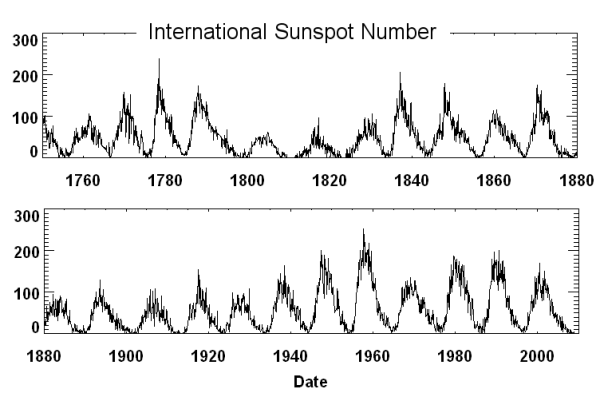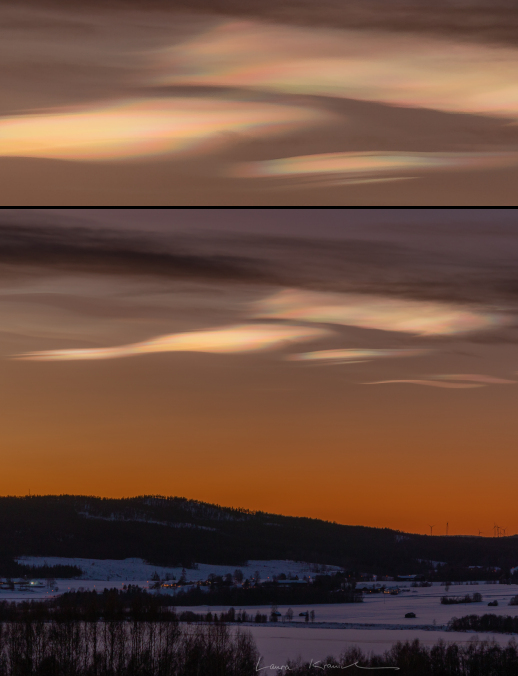Don’t have a filter? Try the projection technique.
SOLAR ACTIVITY & HF PROPAGATION
green flash on the sun
A blog about monitoring and forecasting the stratospheric polar vortexes and how they do and don’t—mostly don’t!*—affect extreme winter weather and seasonal climate. *Seriously, we’ll probably spend a lot of time explaining how the latest wintry weather blast bearing down on us from Canada probably has nothing to do with the polar vortex.
A “hyperbolic comet” is a comet with too much energy to remain trapped inside the solar system. It will visit us only once, with the sun acting as a gravitational slingshot, sending the comet hurtling back into deep space after its flyby. Does that mean Comet Nishimura is an interstellar comet? Not necessarily. It might have come from the Oort Cloud. Indeed, that is more likely.
Because this is Comet Nishimura’s first trip to the inner solar system, it is extra unpredictable. On Sept. 18th, the comet will make its closest approach to the sun deep inside the orbit of Mercury. Anything could happen when intense sunlight touches the comet’s pristine surface for the first time. Possibilities range from dramatic brightening to a disappointing fizzle. Standard models suggest a peak brightness of 3rd magnitude. This would make it visible to the naked eye from rural areas.
Monitoring is encouraged. Comet Nishimura can be found in the pre-dawn sky using backyard telescopes larger than 6 inches. A date of particular interest is Aug. 25th when the comet lines up with Gemini’s brightest stars, Castor and Pollux, making it particularly easy to find. Sky maps: Aug. 18, 19, 20, 21, 22, 23, 24, 25. Ephemeris: from JPL.
You’re not supposed to look straight – Ice Halos
The Sun on 27 January 2023
Oct. 14, 2021: So you think you know what a comet is?
A spectacular sprite leapt into the sky,” he says. “It was generated by a lightning stroke carrying an incredible 160,000 amps of currrent.” (For comparison, typical lightning bolts carry only 30,000 amps.)
FARSIDE SUNSPOTS: There is a sunspot group on the farside of the sun so large it is affecting the way the sun vibrates. Its helioseismic echo may be seen in this farside map. The sun’s rotation will bring this northern active region onto the Earthside of the sun later this week. Stay tuned. Solar flare alerts:SMS Text
Jan. 10, 2020: One day, perhaps in our lifetimes, perhaps a million years from now, the red giant Betelgeuse will dim a little–and then explode. The resulting supernova will rival the full Moon and cast shadows after dark, completely transforming the night skies of Earth. No wonder astronomers are closely tracking the current “fainting of Betelgeuse.”
Jupiter’s images – northern and southern lights
Diffuse, monoenergetic, and broadband aurora:https://agupubs.onlinelibrary.wiley.com/doi/10.1029/2009JA014326 The global precipitation budget
SPACE WEATHER BALLOON DATA:https://spaceweather.com/ Almost once a week, Spaceweather.com and the students of Earth to Sky Calculus fly space weather balloons to the stratosphere over California. These balloons are equipped with sensors that detect secondary cosmic rays, a form of radiation from space that can penetrate all the way down to Earth’s surface. Our monitoring program has been underway without interruption for 6 years, resulting in a unique dataset of in situ atmospheric measurements.
https://spaceweathergallery.com/indiv_upload.php?upload_id=178626
Details:
It was a busy night on October 11 for varied aurora phenomena, as the G2 aurora storm filled the sky with Northern Lights. This was from southern Alberta, where the display of curtains early in the evening showed horizontal “dune” structures, along with isolated blobs. Later, those blobs to the south were joined by a dim red SAR arc, invisible to the eye but the camera recorded it. A time-lapse shows it moving east to west.
Latest results: Our most recent flight on June 25, 2021, confirms a trend of decreasing cosmic radiation:
Cosmic ray dose rates peaked in late 2019, and have been slowly declining ever since. This makes perfect sense. Solar Minimum was in late 2019. During Solar Minimum the sun’s magnetic field weakens, allowing more cosmic rays into the solar system. We expect dose rate to be highest at that time.
Now that Solar Minimum has passed, the sun is waking up again. Solar magnetic fields are strengthening, providing a stiffer barrier to cosmic rays trying to enter the solar system. The decline of cosmic radiation above California is a sign that new Solar Cycle 25 is gaining strength.
The Sunspot Number
Scientists track solar cycles by counting sunspots –– cool planet-sized areas on the Sun where intense magnetic loops poke through the star’s visible surface.
Counting sunspots is not as straightforward as it sounds. Suppose you looked at the Sun through a pair of (properly filtered) low power binoculars — you might be able to see two or three large spots. An observer peering through a high-powered telescope might see 10 or 20. A powerful space-based observatory could see even more — say, 50 to 100. Which is the correct sunspot number?
There are two official sunspot numbers in common use. The first, the daily “Boulder Sunspot Number,” is computed by the NOAA Space Environment Center using a formula devised by Rudolph Wolf in 1848:
R=k (10g+s),
where R is the sunspot number; g is the number of sunspot groups on the solar disk; s is the total number of individual spots in all the groups; and k is a variable scaling factor (usually <1) that accounts for observing conditions and the type of telescope (binoculars, space telescopes, etc.). Scientists combine data from lots of observatories — each with its own k factor — to arrive at a daily value.

Giant red blobs, picket fences, upward branching carrots, and tentacled octopi — these are just a few of the phrases used to describe sprites — spectacular, eerie flashes of colored light high above the tops of powerful thunderstorms that can travel up to 50 miles high in the atmosphere.
Nov. 2, 2021: The CME heading for Earth is a cannibal. SOHO coronagraphs caught the storm cloud leaving the sun on Nov. 2nd following a slow-motion solar flare (M1.7) in the magnetic canopy of sunspot AR2891:
Magnetic storms are great, but even when everything is at rest at Kp.0-1 local K 0 my measurements are sometimes very interesting. Like today, almost a tight line on the graph, but by paying close attention and zooming in, sometimes pulsating signals appear upwards. This is very striking, there are Pc 3 waves on which Pc 1-2 waves are superimposed. In musical terms a form of vibrato modulation. It’s a pity that all this takes place at frequencies that are too low for us, but I’m going to find a way to use this to control synthesizers for example.
Lunar eclipse mirage
Taken by Oscar Martín Mesonero on November 19, 2021 @ Muxía, La Coruña, Spain
RARE TRIPLE MOON HALO: When last Friday’s lunar eclipse began, Arizona photographer Eliot Herman was dismayed to see the sky filling with clouds. Dismay soon turned into delight. “A rare triple halo formed around the Moon,” he explains.
Nov. 16, 2021: Russia just destroyed one of its own satellites. On Nov. 15, 2021, a missile launched from the Plesetsk Cosmodrome struck Kosmos 1408, shattering the old satellite into thousands of pieces. Debris came so close to the ISS that astronauts took shelter in their crew capsules, just in case they had to abandon ship.
The total solar eclipse of December 4, 2021 visits only the continent of Antarctica during the austral Summer. Six months prior, the annular solar eclipse of June 10, 2021 began in southern Canada, traversed Greenland, and passed over the North Pole, before ending over eastern Siberia. So the year of 2021 is neatly bracketed by two polar solar eclipses!
POLAR STRATOSPHERIC CLOUDS: Polar stratospheric clouds appeared above Sweden this week. “We saw them on Dec. 14th, 15th and 16th,” reports Laura Kranich, who photographed the colorful forms over Örnskjöldsvik:

Polar stratospheric clouds (PSCs) are very rare. Normally the stratosphere has no clouds at all. PSCs form when the temperature drops to a staggeringly-low -85 C. Then, and only then, can sparse water molecules in the stratosphere begin to coalesce into tiny ice crystals — the “stuff” of PSCs.
PSCs are widely regarded as the most beautiful clouds on Earth. Their iridescent colors rival the auroras themselves. Once seen they are never forgotten.
In a typical Arctic winter, PSCs appear two or three times at most. This early apparition might herald a good season. Arctic sky watchers, if you see a PSC, photograph it and send it here.
Immense cracks in our planet’s magnetic field can remain open for hours, allowing the solar wind to gush through and power stormy space weather.
Comet C/2021 A1 Leonard
Taken by Michael Jaeger on December 24, 2021 @ Hakos Namibia
A little Romance
The Sun exhibits a well-observed modulation in the number of spots on its disk over a period of about 11 years. From the dawn of modern observational astronomy, sunspots have presented a challenge to
SARs were discovered in 1956 at the beginning of the Space Age. Researchers didn’t know what they were and unwittingly gave them a misleading name: “Stable Auroral Red arcs” or SARs.
In fact, SARs are not auroras. Auroras appear when charged particles rain down from space, hitting the atmosphere and causing it to glow like the picture tube of an old color TV. SARs form differently. They are a sign of heat energy leaking into the upper atmosphere from Earth’s ring current system.
The ring current is a donut-shaped circuit carrying millions of amps around our planet. It skims the orbits of geosynchronous satellites and plays a huge role in determining the severity of geomagnetic storms. Earth is the only rocky planet that has one.
If you want to photograph an SAR, you have to catch the ring current in the act of leaking. This happens during many geomagnetic storms. A G1-class storm was in progress when Kiczenski caught hers. The red arcs have been sighted as far south as Texas. SARs are among the reddest things in the sky, with a monochromatic glow at 6300 Å that comes from atomic oxygen in the upper atmosphere. Unfortunately, the human eye is relatively insensitive to light at this wavelength. SARs are usually so faint that no one notices when they pass overhead. Cameras catch them easily, though. Pro tip for photographers: Use a 6300 Å filter.
Once again, Solar Cycle 25 is exceeding predictions. Sunspot numbers in May 2022 more than doubled NOAA’s forecast, setting the stage for a relatively strong Solar Maximum in early 2025.
Amateur Observers Witness the Return of Venus’ Cloud Discontinuity
THE STARFISH PRIME GEOMAGNETIC STORM: Sixty years ago, one of the biggest geomagnetic storms of the Space Age struck Earth. It didn’t come from the sun.
“We made it ourselves,” recalls Clive Dyer of the University of Surrey Space Centre in Guildford UK. “It was the first anthropogenic space weather event.”
On July 9, 1962, the US military detonated a thermonuclear warhead 250 miles above the Pacific Ocean–a test called “Starfish Prime.” What happened next surprised everyone. Witnesses from Hawaii to New Zealand reported auroras overhead, magnificent midnight “rainbow stripes” that tropical sky watchers had never seen before. Radios fell silent, then suddenly became noisy as streetlights went dark in Honolulu.
A glowing ribbon of purple light running east-west in the night sky has recently been observed by citizen scientists.